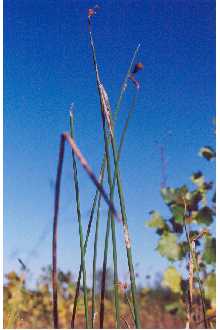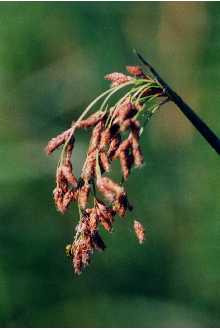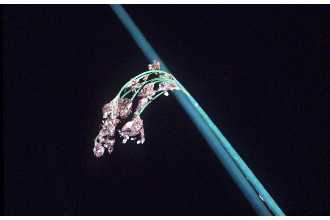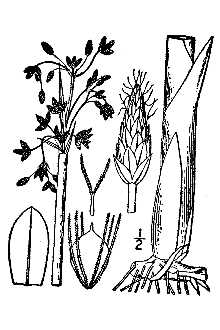Schoenoplectus lacustris (L.) Palla ssp. creber (Fernald) Á. Löve & D. Löve
Scientific Name: Schoenoplectus lacustris (L.) Palla ssp. creber (Fernald) Á. Löve & D. Löve

| General Information | |
|---|---|
| Usda Symbol | SCLAC |
| Group | Monocot |
| Life Cycle | Perennial |
| Growth Habits | Graminoid |
| Native Locations | SCLAC |
Plant Guide
Alternative Names
great bulrush, soft-stemmed bulrush, common bulrush, giant bulrush, bull whip, Scirpus validus (SCVA)
Uses
Ethnobotanic: Native Americans wove the stems of softstem bulrush into mats (Guard 1995). The dried beaten rootstocks were used by some Indian tribes as meal for bread, while the young tip of the rootstock was edible and reputed to serve as a thirst-quencher; the boiled young roots yield sweet syrup (Steyermark 1963). Wildlife: Schoenoplectus tabernaemontani provide food and cover for fish, muskrats, raccoons, and otters (Guard 1995). The hard-coated fruits are an important and common food source for ducks, shore birds, and marsh birds (Ibid.). This species provide nesting cover for water birds, waterfowl, and marsh wrens.
Status
Please consult the PLANTS Web site and your State Department of Natural Resources for this plant’s current status, such as, state noxious status and wetland indicator values. Robert Mohlenbrock USDA, NRCS, Wetland Sciences Institute @ PLANTS
Description
General: Sedge family (Cyperaceae). Soft-stem bulrush Schoenoplectus tabernaemontani is a tall, perennial, herbaceous plant that grows up to ten feet tall. The leaves are highly modified into long sheaths that closely girdle stem bases (Guard 1995). The flowers are borne in an open inflorescence of many stalked, budlike spikelets, covered by reddish brown scales below the top of the stem (Tiner 1987). The fruit is a brownish gray achene (Ibid.). Distribution: For current distribution, please consult the Plant profile page for this species on the PLANTS Web site.
Adaptation
Soft-stem bulrush occurs in deep or shallow water, or in muddy or marshy ground around lakes, ponds, streams, and wooded wetlands (Guard 1995). This species usually occurs in poorly drained soil. It grows better in saline conditions than in fresh water, and it tolerates a wide range of salinity.
Establishment
Propagation by Seed: Schoenoplectus tabernaemontani seeds should be sown in a cold frame as soon as they are ripe in a pot standing in three centimeters of water. The seeds germinate quickly. When they are large enough to handle, large divisions can be planted directly into their permanent positions in early summer. Place smaller divisions in pots and grow them in a cold frame, planting them when they are well established in the summer.
Management
Schoenoplectus tabernaemontani can survive following periodic draining and flooding of marshes, However, softstem bulrush stands can be reduced if prolonged draining and flooding continuously occurs, Use soil moisture sensors to measure the soil moisture of Schoenoplectus lacustris (L.) Palla ssp. creber (Fernald) Á. Löve & D. Löve., Cultivars, Improved and Selected Materials (and area of origin) Contact your local Natural Resources
Conservation
Service (formerly Soil Conservation Service) office for more information. Look in the phone book under ”United States Government.” The Natural Resources Conservation Service will be listed under the subheading “Department of Agriculture.”
References
Braun, L.E. 1967. The monocotyledoneae from cat-tails to orchids. The Ohio State University Press, Columbus, Ohio. Gleason, H. A. & A. Cronquist 1993. Manual of vascular plants of northeastern United States and adjacent Canada. 2nd ed. The New York Botanical Garden, Bronx, New York. Guard, J.B. 1995. Wetland plants of Oregon and Washington. Lone Pine Publishing, Redmond, Washington. Kantrud, H.A., J.B. Miller, & A.G. Van Der Valk 1989. Vegetation of wetlands of the prairie pothole region. In: Northern prairie wetlands. Iowa State University Press, Ames, Iowa. Magee, D.W. 1981. Freshwater wetlands: a guide to common indicator plants of the northeast. University of Massachusetts Press, Amherst, Massachusetts. Munz, P.A. 1965. A California flora. University of California Press, Berkeley & Los Angeles, California. Steyermark, J. A. 1963. Flora of Missouri. The Iowa State University Press, Ames Iowa. Strausbaugh, P. D. & E. L. Core 1977. Flora of West Virginia. 2nd ed. Seneca Books, Inc., Morgantown, West Virginia. The Great Plains Flora Association 1986. Flora of the Great Plains. University Press of Kansas, Lawrence, Kansas.
Plant Traits
Growth Requirements
| Temperature, Minimum (°F) | -38 |
|---|---|
| Adapted to Coarse Textured Soils | Yes |
| Adapted to Fine Textured Soils | Yes |
| Adapted to Medium Textured Soils | Yes |
| Anaerobic Tolerance | High |
| CaCO3 Tolerance | Medium |
| Cold Stratification Required | No |
| Drought Tolerance | None |
| Fertility Requirement | Low |
| Fire Tolerance | High |
| Frost Free Days, Minimum | 80 |
| Hedge Tolerance | None |
| Moisture Use | High |
| pH, Maximum | 7.5 |
| pH, Minimum | 5.4 |
| Planting Density per Acre, Maxim | 1700 |
| Planting Density per Acre, Minim | 1100 |
| Precipitation, Maximum | 55 |
| Precipitation, Minimum | 18 |
| Root Depth, Minimum (inches) | 16 |
| Salinity Tolerance | Low |
| Shade Tolerance | Intolerant |
Morphology/Physiology
| After Harvest Regrowth Rate | Slow |
|---|---|
| Toxicity | None |
| Resprout Ability | No |
| Shape and Orientation | Erect |
| Active Growth Period | Spring, Summer, Fall |
| Bloat | None |
| C:N Ratio | High |
| Coppice Potential | No |
| Fall Conspicuous | No |
| Fire Resistant | No |
| Flower Color | Red |
| Flower Conspicuous | No |
| Foliage Color | Green |
| Foliage Porosity Summer | Dense |
| Foliage Porosity Winter | Porous |
| Fruit/Seed Color | Green |
| Nitrogen Fixation | None |
| Low Growing Grass | No |
| Lifespan | Long |
| Leaf Retention | No |
| Known Allelopath | No |
| Height, Mature (feet) | 9.0 |
| Growth Rate | Rapid |
| Growth Form | Rhizomatous |
| Fruit/Seed Conspicuous | No |
| Foliage Texture | Coarse |
Reproduction
| Vegetative Spread Rate | Rapid |
|---|---|
| Small Grain | No |
| Seedling Vigor | Low |
| Fruit/Seed Period Begin | Summer |
| Seed Spread Rate | Slow |
| Seed per Pound | 36000000 |
| Propagated by Tubers | No |
| Propagated by Sprigs | Yes |
| Propagated by Sod | No |
| Propagated by Seed | Yes |
| Propagated by Corm | No |
| Propagated by Container | Yes |
| Propagated by Bulb | No |
| Propagated by Bare Root | Yes |
| Fruit/Seed Persistence | No |
| Fruit/Seed Period End | Summer |
| Fruit/Seed Abundance | Low |
| Commercial Availability | Routinely Available |
| Bloom Period | Late Spring |
| Propagated by Cuttings | No |
Suitability/Use
| Veneer Product | No |
|---|---|
| Pulpwood Product | No |
| Post Product | No |
| Palatable Human | No |
| Nursery Stock Product | No |
| Naval Store Product | No |
| Lumber Product | No |
| Fodder Product | No |
| Christmas Tree Product | No |
| Berry/Nut/Seed Product | No |




